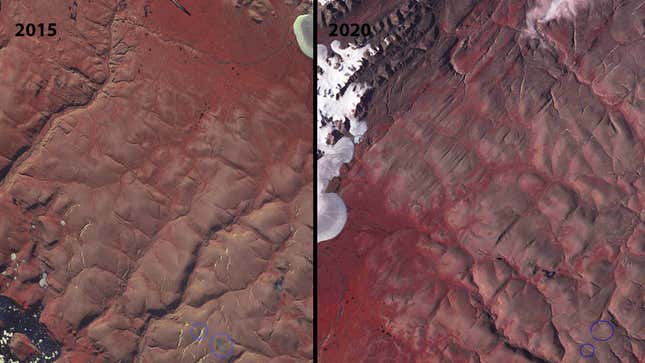
A set of polar ice caps has literally disappeared. We don’t need any more evidence that the Earth is warming to the point of mass instability, but this latest discovery is unsettling, to say the least.
Scientists at the National Snow and Ice Data Center (NSIDC) said last week that the St. Patrick Bay ice caps in the northeastern Ellesmere Island in Nunavut, Canada, are nowhere to be seen on satellite imagery. Researchers long suspected that this would be possible, but the prediction has come a bit sooner than expected.
An ice cap is a sort of mini-glacier. These formations stretch less than 19,300 square miles, so they’re smaller than ice sheets. The St. Patrick Bay ice caps were truly tiny: In 1959, the largest one was merely 2.9 square miles, and the smaller one was only 1.1 square miles. By 2001, the two ice caps had shrunk to 62% and 58% of their 1959 size, respectively.
In 2017, a team published a paper suggesting that the ice caps would be gone in the next five years due to rapidly warming temperatures in the Arctic. Well, seems it was more like three years. The ice caps are missing in satellite photos from July 14, 2020. This year has been especially brutal throughout the region. Recent months have been plagued by heatwaves and wildfires across the Arctic. This extreme heat likely contributed to the melting of the ice caps. Research has found that summers in the region haven’t been this warm in 115,000 years.
Still, these two ice caps, along with all those scattered along the waters that feed into the Baffin Bay, have been suffering for quite some time. The Barnes ice cap, for instance, holds some of the world’s most ancient ice, yet satellite imagery shows how quickly it’s been retreating over the last decade. Meanwhile, the St. Patrick Bay ice caps formed only a few centuries ago. Since at least 1959, they’ve been dramatically retreating. Now, they’re gone.

“We’ve long known that as climate change takes hold, the effects would be especially pronounced in the Arctic,” said Mark Serreze, director of NSIDC, in a press release. “But the death of those two little caps that I once knew so well has made climate change very personal. All that’s left are some photographs and a lot of memories.”
He first visited these ice caps in 1982 as a graduate student. He’s been studying and watching them ever since. Back then, global warming wasn’t the urgent crisis it’s become. Events such as this show just how damaging its impacts can be. They remind us that the climate crisis is here; it’s arrived. With every ice cap or ice sheet that melts, our oceans rise just a little bit more. Some may not care for the Arctic lands up north, but they should care about their beaches and cities that’ll wind up underwater if we continue on this path.